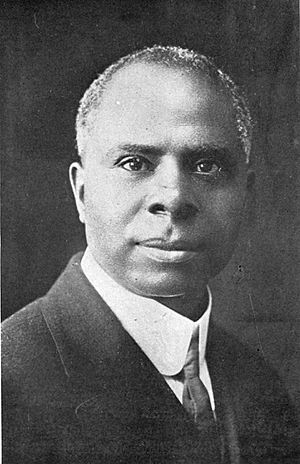Monroe Work facts for kids
Quick facts for kids
Monroe Work
|
|
|---|---|
 |
|
| Born |
Monroe Nathan Work
August 15, 1866 |
| Died | May 2, 1945 (aged 78) Tuskegee, Alabama, U.S.
|
| Nationality | American |
| Alma mater | University of Chicago (B.A. and M.A.) |
| Occupation | Sociologist |
| Known for | Department of Records and Research at the Tuskegee Institute |
|
Notable work
|
Negro Year Book A Bibliography of the Negro in Africa and America |
| Spouse(s) | Florence E. Hendrickson |
| Awards | Harmon Award in Education (1928) |
Monroe Nathan Work (born August 15, 1866 – died May 2, 1945) was an important African-American sociologist. He created the Department of Records and Research at the Tuskegee Institute in 1908. He wrote books like the Negro Year Book and A Bibliography of the Negro in Africa and America. This last book listed about 17,000 references about African Americans.
Monroe Work helped make Tuskegee Institute well-known across the country. He worked hard to stop lynching, which was a terrible form of racial violence. He also supported the National Negro Health Week movement. His books were very important because it was hard to find information about black Americans at that time. Many academics in the US often ignored or overlooked this kind of research. This was a period when Jim Crow laws were growing, and African Americans faced unfair treatment and violence.
Contents
Who Was Monroe Work?
Monroe Work was a key figure in documenting the lives and struggles of African Americans. His work helped bring important facts to light. He made sure that the experiences of black Americans were recorded and shared.
Early Life and Education
Work was born in Iredell County, North Carolina. His parents had been enslaved. In 1867, his family moved to Cairo, Illinois, where his father became a farmer. When he was 23, Work went to Arkansas City High School (Kansas). This was a school where students of different races learned together. He did very well, graduating third in his class.
After high school, he trained at the Chicago Theological Seminary. Then, he went to the University of Chicago to study sociology. He researched why crime rates were higher among black people living in poor areas. His paper on this topic was the first article by an African American published in the American Journal of Sociology. He earned a Bachelor of Arts degree in Philosophy and a Master of Arts degree in Sociology from the University of Chicago.
In 1903, Work became a professor at Georgia State Industrial College in Savannah, Georgia. He married Florence E. Hendrickson in Savannah in 1904. In 1905, he was invited by W. E. B. Du Bois to attend a meeting of the Niagara Movement. This group worked for equal rights for African Americans.
Making a Difference at Tuskegee
In 1908, Booker T. Washington asked Work to start the Department of Records and Research at the Tuskegee Institute. While there, Work began publishing the Negro Year Book. This book included his regular reports on lynching. Because of his careful work, the Tuskegee Institute became a trusted source for information on this racial violence.
Work's research was very important. It was hard to find academic work by and about black Americans back then. Many scholars in the US did not pay attention to these topics.
The Negro Year Book
The Negro Yearbook was an annual encyclopedia about African American history. It was published at the Tuskegee Institute. Monroe Work was its editor for many years. This book collected facts, social information, and lists of important people. It showed the progress of black people in the US since slavery ended.
The Negro Year Book also included Work's detailed reports on lynching. These reports were so complete that the Tuskegee Institute became a leading source on this topic.
Fighting for Justice
In 1928, Work received the Harmon Award in Education. He earned this award for his research and his work on the Negro Year Book and A Bibliography of the Negro in Africa and America.
In 1918, he joined the American Negro Academy. This was an important group of African-American scholars and activists. They worked to challenge racist ideas and promote equality for black people. They also published the history and social studies of African American life.
His Legacy
Monroe Work and his wife did not have children. He passed away in Tuskegee in 1945. His work left a lasting impact by documenting African American history and fighting for justice.
Selected works
- Annual editions of Negro Year Book: Second: 1913; Third: 1914–1915; Fourth: 1916–1917 ; Fifth: 1918–1919; Sixth: 1921–1922; Seventh: 1925–1926 ; Eighth: 1931–1932; Ninth: 1937–1938
- Work, Monroe Nathan. Fifty Years Progress: Negro Business, 1867–1917. [Tuskegee, Ala.] : Tuskegee Institute, [1918?]

